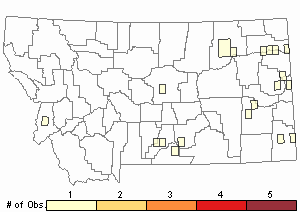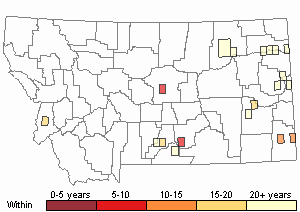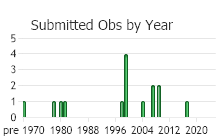View in other NatureServe Network Field Guides
NatureServe
Montana
Utah
Wyoming
Idaho
Wisconsin
British Columbia
South Carolina
Yukon
California
New York
Woodbine - Parthenocissus vitacea
Other Names:
Parthenocisus inserta (in part)
Native Species
Global Rank:
G5
State Rank:
S3S4
(see State Rank Reason below)
C-value:
4
Agency Status
USFWS:
USFS:
BLM:
External Links
State Rank Reason (see State Rank above)
Parthenocissus vitacea is a vine that is considered native to the Great Plains and introduced into the Pacific Northwest (Moore and Wen in Flora of North America 2016; Giblin et al. [eds.] 2018). In Montana, populations east of the Continental Divide are generally considered native, especially if derived from indigenous stock, while west of the divide populations are introduced, either planted into or likely escaped from gardens. Where native, Parthenocissus vitacea grows in woody draws and in riparian habitat along streams, that might also be adjacent to lawns or pastures. Populations anywhere in the state could be considered introduced if planted from non-local genetic sources into locations where the species was not previously documented. Overall, populations in its native range, east of the Continental Divide, appear to be stable. As an attractive vine that is native to a portion of Montana it provides a better landscaping alternative than its introduced relative, Parthenocissus quinquefolia. Current data on locations, population sizes, and threats in natural habitat east of the Continental Divide are needed.
General Description
PLANTS: Woody vines with tendrils. Tendrils are 3- to 5-branched, lack adhesive disks, and are oppositely arranged in the upper leaf axils. Source: Lesica et al. 2012.
LEAVES: Alternately arranged on branches. Leaf blade is palmately divided into 5 leaflets. Leaflets are 5, narrowly obovate in shape, with sparse hairs (glabrate), 3–10 cm long. Source: Lesica et al. 2012.
INFLORESCENCE: A dichotomously branched, hemispheric panicle that arises from the leaf axils. Flowers with reduced sepals and 5 distinct greenish to reddish petals of 2–3 mm long. Berry is 6–10 mm wide. Sources: Lesica et al. 2012; Wen in Flora of North America [FNA] 2016.
TAXONOMY & NOMENCLATURE
Parthenocissus comes from the Greek words Parthenos meaning 'virgin' and kissos meaning 'ivy'.
The Montana Natural Heritage Program follows the taxonomic treatment by Moore and Wen in the Flora of North America (FNA; 2016). The original description and illustration of Vitis inserta described branched tendrils and shows adhesive discs or tendencies to possess discs which are traits not associated with Parthenocissus vitacea. Therefore, Vitis inserta is treated in FNA as a synonym to Parthenocissus quinquifolia, and not to P. vitacea.
Phenology
Flowering from may to June and fruiting from August to September (Wen in FNA 2016).
Diagnostic Characteristics
In Montana species of the
Grape Family (
Vitaceae) can be separated by the degree of lobing in the leaf.
Grapes (
Vitis) have single leaves with shallow lobes while
Woodbines and
Virginia Creepers (
Parthenocissus) have a single leaf palmately divided into distinct leaflets.
Montana has 2
Parthenocissus species:
Woodbine -
Parthenocissus vitacea, native and desireable
*Tendrils: Without an adhesive disc. Look closely where it attaches to a substrate.
*Inflorescence: Panicle is dichotomously branched.
Virginia Creeper -
Parthenocissus quinquefolia, exotic
*Tendrils: With an adhesive disc. Look closely where it attaches to a substrate. Discs are easily broken off unless carefully remove.
*Inflorescence: Panicle has a central axis.
Species Range
Montana Range
Range Descriptions

 Native
Native
Range Comments
Woodbine is found from British Columbia to Quebec in Canada, and south to California, Arizona, Utah, Texas, and east to the Midwest and eastern USA, but apparently is not in the southeastern USA (Moore and Wen in FNA 2016).
Woodbine is considered to be native to the Great Plains region which includes portions of the eastern half of Montana. It is considered to be introduced into the Pacific Northwest (Giblin et al. [eds.] 2018). In Montana, populations east of the Continental Divide are generally considered native, especially if derived from indigenous stock, while west of the divide populations are introduced, either planted into or likely escaped from gardens. Populations anywhere in the state could be considered introduced if planted from non-local genetic sources into locations where the species was not previously documented.
Observations in Montana Natural Heritage Program Database
Number of Observations: 18
(Click on the following maps and charts to see full sized version)
Map Help and Descriptions
Relative Density

Recency



 (Observations spanning multiple months or years are excluded from time charts)
(Observations spanning multiple months or years are excluded from time charts)
Habitat
In Montana plants grow in riparian forests in the plains zone (Lesica et al. 2012). Where native, Woodbine grows in woody draws and in riparian habitat along streams, that might also be adjacent to lawns or pastures.
Reproductive Characteristics
Plants reproduce by seed.
FLOWER
Unisexual, perfect, hypogynous, and 5-merous. Sepals are reduced and obscurely lobed. Petals are 5, separate, and 2-3 mm long. Stamens are 5. Pistil has a superior ovary with 1 style.
FRUIT
Fruit is a berry. Berry is round and 2-celled with 2 seeds per cell.
Economic Value
Woodbine can be commercially available for landscaping. However, information on the genetic source of plants sold in Montana is currently unknown.
Stewardship Responsibility
References
- Literature Cited AboveLegend:
 View Online Publication
View Online Publication Flora of North America Editorial Committee, eds. 2016. Flora of North America north of Mexico, Vol. 12. Magnoliophyta: Vitaceae to Garryaceae. Oxford University Press, Inc. New York.
Flora of North America Editorial Committee, eds. 2016. Flora of North America north of Mexico, Vol. 12. Magnoliophyta: Vitaceae to Garryaceae. Oxford University Press, Inc. New York. Lesica, P., M.T. Lavin, and P.F. Stickney. 2012. Manual of Montana Vascular Plants. Fort Worth, TX: BRIT Press. viii + 771 p.
Lesica, P., M.T. Lavin, and P.F. Stickney. 2012. Manual of Montana Vascular Plants. Fort Worth, TX: BRIT Press. viii + 771 p.
- Additional ReferencesLegend:
 View Online Publication
View Online Publication
Do you know of a citation we're missing? Lesica, P., M.T. Lavin, and P.F. Stickney. 2022. Manual of Montana Vascular Plants, Second Edition. Fort Worth, TX: BRIT Press. viii + 779 p.
Lesica, P., M.T. Lavin, and P.F. Stickney. 2022. Manual of Montana Vascular Plants, Second Edition. Fort Worth, TX: BRIT Press. viii + 779 p. Wood, A.K. 1987. Ecology of a prairie mule deer population. Ph.D. Dissertation. Bozeman, MT: Montana State University. 205 p.
Wood, A.K. 1987. Ecology of a prairie mule deer population. Ph.D. Dissertation. Bozeman, MT: Montana State University. 205 p.
- Web Search Engines for Articles on "Woodbine"





